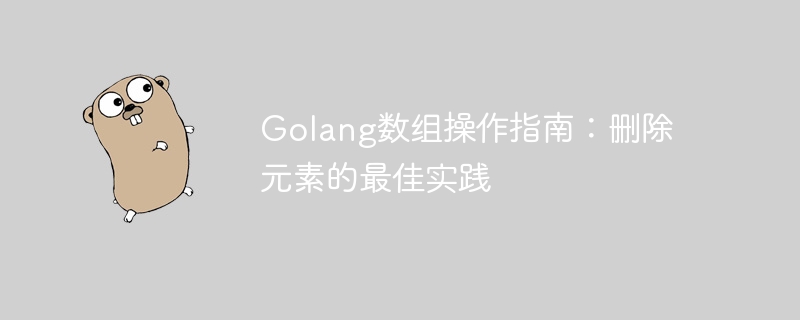Home >Backend Development >Golang >Best Practices: Guide to deleting elements from arrays in Golang
Best Practices: Guide to deleting elements from arrays in Golang
- 王林Original
- 2024-01-24 10:55:06782browse

Golang Array Operation Guide: Best practices for deleting elements, specific code examples are required
Introduction:
In Golang, arrays are a common type of data A structure used to store a set of elements of the same type. Sometimes, we need to delete elements from an array to meet specific needs. This article will introduce the best practices for deleting array elements in Golang and provide specific code examples.
1. Review of basic knowledge
Before we begin, let’s review the basic knowledge of Golang arrays. In Golang, an array is a fixed-length data structure. Its length is determined when it is created and cannot be changed. The length of an array is part of the type, so arrays with different lengths are not comparable. The index of the array starts from 0, and the index of the last element is the length minus 1.
2. Use slicing to delete elements
In Golang, the length of the array cannot be changed, so we cannot directly delete elements in the array. However, we can use slices to achieve similar functionality. A slice is a dynamic view of an array that points to a continuous sequence of elements. By creating a new slice, we can achieve the effect of deleting array elements.
The specific code examples are as follows:
package main
import "fmt"
func main() {
// 创建一个包含整数的数组
numbers := []int{1, 2, 3, 4, 5}
// 删除数组中的第三个元素
numbers = append(numbers[:2], numbers[3:]...)
// 输出修改后的数组
fmt.Println(numbers)
}In the above example, we use slicing to delete the third element in the array. First, we use numbers[:2] to select the first two elements in the array, and use numbers[3:] to select everything starting from the fourth element to the end element. We then expand the slice using the ... operator and merge the two slices into a new slice using the append() function.
3. Deleting elements through reassignment
In addition to using slicing, we can also delete array elements through reassignment. The specific code example is as follows:
package main
import "fmt"
func main() {
// 创建一个包含整数的数组
numbers := []int{1, 2, 3, 4, 5}
// 删除数组中的第三个元素
for i := 2; i < len(numbers)-1; i++ {
numbers[i] = numbers[i+1]
}
numbers = numbers[:len(numbers)-1]
// 输出修改后的数组
fmt.Println(numbers)
}In the above example, we use a loop to move the third element and subsequent elements in the array forward one position, and delete the last element. Finally, we use slicing to reassign the value to the original array, thereby achieving the effect of deleting elements.
Summary:
This article introduces the best practices for deleting array elements in Golang and provides specific code examples. By using slicing or reassignment, we can delete array elements. In actual development, choosing the appropriate method according to specific needs can improve the readability and efficiency of the code.
I hope this article will be helpful to your learning and practice in Golang array operations!
The above is the detailed content of Best Practices: Guide to deleting elements from arrays in Golang. For more information, please follow other related articles on the PHP Chinese website!

